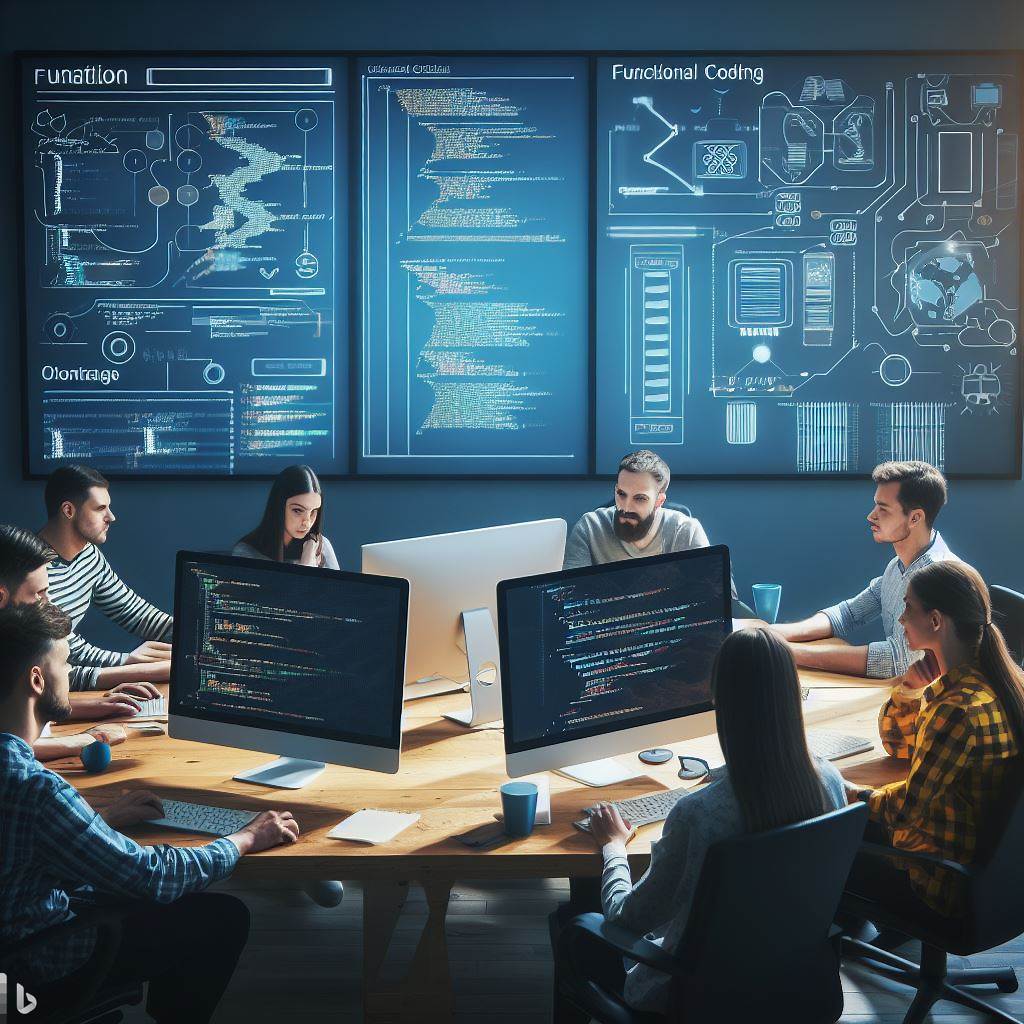Introduction
Welcome to the world of 3D coding wallpapers! In this post, we will explore the exciting realm of creating personalized wallpapers using the powerful Blender software.
Coding wallpapers have gained immense popularity among developers, as they not only showcase their passion for coding but also add a touch of uniqueness to their workspace.
With 3D coding wallpapers, developers can take their creativity to a whole new level.
One of the major benefits of creating personalized coding wallpapers is the ability to express one’s individuality.
By using Blender software, developers can design custom wallpapers that reflect their personality, interests, or even project themes.
These wallpapers serve as a constant source of inspiration and motivation during long coding sessions.
Blender, known for its versatility and powerful 3D modeling capabilities, provides developers with a wide range of tools and features to bring their coding wallpapers to life.
From creating complex 3D objects to applying stunning textures and lighting effects, Blender allows developers to unleash their creativity and explore limitless possibilities.
In addition to personalization, 3D coding wallpapers can also enhance productivity.
A visually appealing and engaging wallpaper can create a pleasant working environment, boost focus, and increase motivation.
By surrounding themselves with inspiring visuals, developers can elevate their coding experience and improve their workflow.
So, whether you are a seasoned developer or a coding enthusiast, dive into the world of 3D coding wallpapers using Blender software.
Let your imagination soar and create wallpapers that truly represent your coding journey.
Overview of Blender software
- Blender software is a powerful tool for 3D modeling and animation.
- It is widely used in the industry for creating high-quality graphics and visual effects.
- Blender offers a comprehensive set of features that make it a preferred choice among professionals.
- The software is available for free, making it accessible to a wide range of users.
- Blender is compatible with different operating systems, including Windows, macOS, and Linux.
- It has a user-friendly interface that simplifies the process of creating 3D coding wallpapers.
- The software provides a wide range of tools and functionalities to create complex models and animations.
Why Blender is a popular choice for 3D modeling and animation
- Blender offers a powerful rendering engine that produces realistic and high-quality visuals.
- The software supports a variety of modeling techniques, including polygonal modeling, sculpting, and texturing.
- Blender provides advanced features for rigging and animating characters or objects.
- It has a powerful physics engine that allows for realistic simulations of fluids, particles, and rigid bodies.
- Blender supports the creation of procedural textures and materials, giving artists more control over their designs.
- The software provides an extensive library of pre-built models, materials, and textures that can be used in projects.
- Blender offers a wide range of export options, allowing users to easily share their work with other software or platforms.
Benefits of Blender’s user-friendly interface and availability on different operating systems
- The user-friendly interface of Blender makes it easy for beginners to get started with 3D modeling and animation.
- The software provides clear and intuitive menus, toolbars, and shortcuts, enhancing the productivity of artists.
- Blender’s interface can be customized according to the user’s preferences, improving workflow efficiency.
- Blender’s availability on different operating systems ensures that users can work with the software on their preferred platform.
- It allows for seamless collaboration between artists working on different operating systems.
- Blender’s cross-platform compatibility makes it a versatile software for studios and freelancers.
- The availability of Blender for free eliminates any budget constraints for aspiring artists and enthusiasts.
In review, Blender software is a powerful and popular choice for creating 3D coding wallpapers.
Its comprehensive set of features, user-friendly interface, and compatibility with different operating systems make it a preferred tool among professionals and beginners alike.
Tech Consulting Tailored to Your Coding Journey
Get expert guidance in coding with a personalized consultation. Receive unique, actionable insights delivered in 1-3 business days.
Get StartedRead: The Importance of Portfolio Projects for Entry-Level Coders
Setting up Blender for wallpaper creation
- Download Blender software from the official website (www.blender.org).
- Install Blender by following the step-by-step installation instructions.
- Ensure that your computer meets the system requirements for Blender.
- Check for compatibility considerations with your operating system and hardware.
- It is recommended to update to the latest version of Blender for bug fixes and new features.
Blender is a powerful software tool used for creating 3D graphics and animations.
It is widely used by professionals and enthusiasts in various industries such as gaming, animation, and visual effects.
One of the exciting applications of Blender is creating visually stunning coding wallpapers.
Step-by-step instructions on downloading and installing Blender software
To begin creating coding wallpapers with Blender, you first need to set up the software on your computer.
Follow these step-by-step instructions to download and install Blender:
- Go to the official Blender website at www.blender.org.
- Navigate to the “Download” section and click on the download button for your operating system (Windows, Mac, or Linux).
- Save the installation file to your computer. Once the download is complete, locate the file and double-click on it to start the installation process.
- Follow the on-screen prompts to install Blender. You may need to choose a destination folder for the installation and agree to the terms and conditions.
- Once the installation is complete, you can launch Blender by double-clicking on the shortcut icon on your desktop or searching for it in the Start menu.
System requirements and compatibility considerations
Before installing Blender, it is important to check the system requirements and compatibility considerations.
Blender requires a relatively modern computer with decent hardware specifications.
Ensure that your computer meets the minimum requirements to run Blender smoothly.
It is also essential to consider the compatibility of Blender with your operating system and any specific hardware configurations you may have.
The importance of updating to the latest version
Keeping your Blender software up to date is crucial for accessing bug fixes and new features.
The Blender community is constantly working on improving and enhancing the software, and new updates are released periodically.
To update Blender to the latest version, follow these steps:
- Launch Blender on your computer.
- Go to the “Help” menu and click on the “Check for Updates” option.
- Blender will check for updates and prompt you to download the latest version if available.
- Follow the on-screen instructions to complete the update process.
Updating Blender not only ensures that you have the latest bug fixes and improvements, but it also allows you to take advantage of new features that can enhance your wallpaper creation process.
Build Your Vision, Perfectly Tailored
Get a custom-built website or application that matches your vision and needs. Stand out from the crowd with a solution designed just for you—professional, scalable, and seamless.
Get StartedFurthermore, setting up Blender for creating 3D coding wallpapers requires downloading and installing the software, considering system requirements and compatibility, and keeping the software up to date.
By following these steps, you’ll be ready to unleash your creativity and design stunning wallpapers using Blender’s powerful 3D capabilities.
Read: Entry-Level Coding Jobs: Remote vs In-Person Opportunities
Gathering resources and inspiration
Gathering resources and inspiration is an essential step in creating 3D coding wallpapers using Blender software.
Before starting the design process, brainstorming and collecting ideas play a significant role in achieving desirable results.
Brainstorming allows designers to explore various concepts and possibilities before settling on a specific design direction.
It helps in generating a pool of ideas that can be refined and developed further.
This process encourages creativity and ensures that the final outcome aligns with the intended purpose.
Where to find inspiration for coding wallpapers
When it comes to finding inspiration for coding wallpapers, several avenues can be explored:
- Online resources: There are numerous websites and online communities dedicated to showcasing creative designs and wallpapers. Platforms like Dribbble, Behance, and Pinterest serve as a great starting point to get inspired by fellow designers’ work.
- Social media groups: Engaging with online communities and groups on platforms like Facebook, Reddit, and Discord allows designers to connect with like-minded individuals. These groups often share ideas, concepts, and resources related to coding wallpapers.
- Software-specific forums: Blender has a dedicated community that actively shares their creations, workflows, and tips. Participating in forums and discussions related to Blender can provide valuable insights and references for designing 3D coding wallpapers.
- Websites with 3D wallpapers: Exploring websites specifically designed to showcase 3D wallpapers can give designers a better understanding of the prevailing trends and styles. Websites like Wallpaper Engine, Wallpaper Abyss, and ArtStation can serve as a rich source of inspiration.
Once designers have gathered a range of resources and ideas, it’s essential to filter and refine them to create a cohesive design.
Analyzing the collected references helps in identifying common elements, color schemes, composition techniques, or unique features that can be incorporated into the coding wallpapers.
During this process, designers should aim to strike a balance between originality and familiarity.
While the gathered inspiration serves as a reference point, it’s crucial to add personal touches and innovative elements to make the design stand out.
Online resources, social media groups, and websites with 3D wallpapers for reference
To summarize, gathering resources and inspiration through brainstorming and collecting ideas is crucial for creating visually appealing 3D coding wallpapers with Blender software.
Optimize Your Profile, Get Noticed
Make your resume and LinkedIn stand out to employers with a profile that highlights your technical skills and project experience. Elevate your career with a polished and professional presence.
Get NoticedPlatforms like Dribbble, Behance, and Pinterest, along with social media groups and Blender-specific forums, are excellent sources for finding inspiration.
Exploring websites dedicated to 3D wallpapers can further enhance the design process.
By leveraging these resources effectively, designers can create wallpapers that resonate with coding enthusiasts and reflect their unique creativity.
Read: Which Programming Languages Are Best for Entry-Level Jobs?
Designing the coding wallpaper
Planning and sketching the layout before diving into 3D modeling is crucial for a successful coding wallpaper design.
By visualizing the elements and arrangement in advance, you can ensure a smooth workflow and achieve the desired result.
Importance of planning and sketching
- Saves time and effort: Planning allows you to identify potential issues and make necessary adjustments before starting the modeling process. It helps in avoiding costly mistakes and streamlines the overall design process.
- Enhances creativity: Sketching helps in exploring different layout possibilities and experimenting with various compositions. It allows you to visualize the final design and make informed decisions about the positioning of different elements.
- Better communication: A well-defined sketch can serve as a communication tool between you and your clients or teammates. It helps in conveying your design ideas and ensures that everyone involved has a clear understanding of the project’s vision.
Elements for coding wallpaper design
- Code snippets: Including code snippets relevant to different programming languages is a great way to showcase your expertise and add authenticity to the wallpaper design. Choose snippets that are visually appealing and represent popular programming concepts.
- Programming languages: Incorporating logos or symbols of programming languages can instantly communicate the focus of the wallpaper. It helps in attracting the attention of programmers and creating a connection with the target audience.
- Programming concepts: Concepts such as algorithms, data structures, or design patterns can be represented using illustrations or visual metaphors. Including these elements not only adds depth to the wallpaper but also serves as a source of inspiration for programmers.
Tips and techniques for visually appealing compositions
- Use the rule of thirds: Divide your canvas into a 3×3 grid and position the main elements along the intersecting lines. This creates a visually balanced composition and draws the viewer’s attention to the focal point.
- Contrast and color harmony: Emphasize important elements by using contrasting colors or making them stand out from the background. Ensure the color scheme harmonizes with the overall aesthetic and doesn’t distract from the main subject.
- Depth and perspective: Utilize depth of field techniques to create a sense of depth and realism in your 3D wallpaper. Experiment with different camera angles and perspectives to add visual interest and make the composition visually engaging.
- Balance and symmetry: Balance the composition by distributing visual weight evenly across the canvas. Achieve symmetry or asymmetry based on the overall design goal and aesthetic requirements.
- Lighting and shadows: Proper lighting can drastically enhance the visual appeal of your wallpaper. Experiment with different lighting setups to create interesting shadows and highlights, adding depth and dimension to the composition.
All in all, designing a coding wallpaper using Blender software requires careful planning and sketching.
Consider the elements you want to include, such as code snippets, programming languages, and concepts, and apply composition techniques for visually appealing results.
By following these tips and techniques, you can create stunning 3D coding wallpapers that inspire and captivate programmers.
Read: Integrating Coding Robots into Your Homeschool Curriculum

Using Blender for 3D modeling
Blender is an incredible software program for 3D modeling.
It offers a wide range of tools and features that allow users to create stunning and realistic 3D objects.
In this section, we will explore the basics of Blender’s interface, provide step-by-step instructions on creating basic 3D objects, and explain the importance of using materials, textures, and lighting to enhance the 3D models.
1. The Basics of Blender’s Interface
Blender’s interface consists of viewports, which display different perspectives of the 3D scene.
Users can manipulate objects by selecting them and using various tools for scaling, rotating, etc.
Camera controls allow users to adjust the view and focal length for better visualization.
2. Step-by-Step Instructions on Creating Basic 3D Objects Relevant to Coding Wallpapers
- To create a cube, navigate to the “Add” menu, select “Mesh,” and then choose “Cube.”
- For a sphere, go to the “Add” menu, select “Mesh,” and choose “UV Sphere.”
- To add text objects, press “Shift + A,” select “Text,” and type your desired text.
3. The Importance of Using Materials, Textures, and Lighting
Materials give objects color, reflectivity, or transparency, making them more realistic.
Textures can be applied to objects to add graphics or patterns, enhancing their appearance.
Lighting plays a crucial role in creating depth, shadows, and highlights, making the scene more vibrant.
4. Additional Tips and Techniques for Creating 3D Coding Wallpapers
- Experiment with different materials, textures, and lighting setups to achieve desired effects.
- Use modifiers to add complexity to objects, such as beveling edges or adding subdivisions.
- Take advantage of Blender’s vast library of pre-built models and textures for quicker results.
5. Time to Get Creative and Customize Your 3D Coding Wallpapers
- Combine multiple 3D objects, adjust their positioning and scale, and experiment with different layouts.
- Play around with different materials and textures to bring out the desired aesthetic.
- Experiment with various lighting setups to create moods and highlight important elements.
In general, Blender is an excellent software tool for creating 3D coding wallpapers.
By understanding the basics of Blender’s interface, following step-by-step instructions for creating basic 3D objects, and utilizing materials, textures, and lighting effectively, users can create stunning wallpapers that are visually appealing and unique.
So, dive into Blender and let your creativity soar!
Adding coding elements to the wallpaper
- Import code snippets or programming languages icons by using Blender’s import function.
- Integrate the imported elements into the 3D scene by placing them strategically.
- Use coding-related icons such as brackets, semicolons, or variables to enhance the overall design
How to import and integrate code snippets, programming languages, or coding-related icon
- Open Blender and navigate to the Import menu.
- Choose the file format of the coding elements you want to include, such as .obj or .fbx.
- Browse your computer for the desired files and click “Import” to bring them into the Blender scene.
- Position the imported code snippets or icons within the scene using the 3D viewport controls.
- Arrange them in a visually appealing and coherent manner, considering composition and balance.
Techniques for arranging and positioning text objects or code fragments within the 3D scene
- Create or import text objects that represent code fragments or programming languages.
- Adjust the size, font, and formatting of the text objects to ensure legibility.
- Consider the perspective and camera angle of the 3D scene to place the text objects appropriately.
- Use depth of field or motion blur effects to add a dynamic feel to the scene.
Tips on making the coding elements visually appealing and legible
- Choose a color scheme that complements the coding elements while maintaining readability.
- Add textures or materials to the coding elements to make them look more realistic and visually interesting.
- Experiment with lighting to bring attention to the coding elements and create depth.
- Use post-processing effects, such as bloom or vignette, to enhance the overall look of the wallpaper.
In short, creating 3D coding wallpapers with Blender software allows for a unique and visually appealing representation of programming.
By importing and integrating code snippets, programming languages icons, and arranging text objects within the 3D scene, you can create wallpapers that are both visually appealing and legible.
Experimenting with different techniques and paying attention to details such as color schemes, textures, lighting, and post-processing effects will result in stunning coding wallpapers that coding enthusiasts will appreciate.
Rendering and post-processing the wallpaper
When it comes to creating 3D coding wallpapers with Blender software, rendering and post-processing are crucial steps to achieve a stunning final result.
In this section, we will explore the rendering settings in Blender, how to set up the wallpaper’s resolution and aspect ratio, experiment with different lighting setups and camera angles, as well as introduce post-processing techniques.
Rendering settings in Blender and setting up the wallpaper’s resolution and aspect ratio
Before diving into the rendering process, it’s important to configure the settings in Blender to ensure optimal results.
Start by accessing the “Render” tab in the Properties Editor.
Here, you can adjust parameters such as the render engine, sample size, and output format.
Next, in order to set up the wallpaper’s resolution and aspect ratio, go to the “Dimensions” section.
Here, you can define the pixel dimensions and aspect ratio according to your desired output.
It’s crucial to consider the target platform or medium where the wallpaper will be used to ensure proper display.
The importance of experimenting with different lighting setups and camera angles
Lighting plays a crucial role in enhancing the overall visual appeal of the wallpaper.
Blender offers various lighting options such as point lights, spotlights, and area lights.
Experimenting with different setups allows you to achieve the desired mood and highlight specific elements.
Similarly, camera angles greatly influence the composition and storytelling of the wallpaper.
Blender provides flexible camera controls, enabling you to position the camera from different viewpoints.
This allows for creative perspectives that can make your wallpaper truly unique and engaging.
Post-processing techniques
Once the rendering is complete, it’s time to explore post-processing techniques to enhance the final output.
Blender offers a range of tools, filters, and effects that can be applied to the rendered image.
One important post-processing technique is adjusting colors.
Blender allows you to tweak the color balance, saturation, and hue to create the desired atmosphere.
You can experiment with vibrant or muted colors to match your personal preference or the theme of the wallpaper.
Adding effects can also enhance the visual impact of the wallpaper. Blender provides options to add lens flares, motion blur, depth of field, and more.
These effects can add depth and realism to the scene, making it more visually striking.
Finally, enhancing contrast can make your wallpaper stand out. Blender enables you to adjust the brightness, contrast, and gamma settings.
By carefully manipulating these parameters, you can create a visually pleasing balance between light and dark areas, making important elements pop.
In essence, rendering and post-processing play a vital role in creating 3D coding wallpapers with Blender software.
By understanding the rendering settings, setting up the wallpaper’s resolution and aspect ratio, experimenting with different lighting setups and camera angles, and applying post-processing techniques, you can elevate your wallpapers to the next level.
Remember to constantly experiment and iterate to achieve the desired visual impact.
Exporting and sharing the wallpaper
In this section, we will explore the final steps of creating 3D coding wallpapers with Blender software.
Once we have finished rendering the wallpaper, it is important to know how to export and share our creation.
How to save the rendered wallpaper image in different formats (JPEG, PNG)
To save the rendered wallpaper image in different formats, such as JPEG or PNG, follow these steps:
- Ensure your rendered image is displayed in the Image Editor.
- Go to the Image menu and select “Save As Image” or use the shortcut Shift + Ctrl + S.
- In the file browser, choose the desired location and enter a name for your wallpaper.
- Choose the file format (JPEG or PNG) from the drop-down menu in the file browser.
- Click “Save Image” to export the wallpaper in the chosen format.
Optimizing File Size without Sacrificing Quality
When exporting the wallpaper, it is important to optimize the file size without compromising its quality. Follow these tips:
- Choose the appropriate file format – JPEG is recommended for photographs and complex scenes, while PNG is better for images with sharp lines and transparency.
- Adjust the compression level – In JPEG, increasing the compression level reduces file size but may result in visible artifacts.
- Consider resolution – Reduce the resolution if the wallpaper does not need to be printed or displayed on large screens.
- Minimize unnecessary details – Remove elements that do not contribute significantly to the design to reduce file size.
- Use optimization tools – Various software and online tools can further compress images without losing too much quality.
Sharing the Created Wallpapers
Once you have your 3D coding wallpapers ready, it’s time to share them with other coding enthusiasts.
Here are some suggestions on platforms or communities:
- Reddit’s coding community – Share your wallpapers on subreddit threads dedicated to coding or 3D design.
- DeviantArt – This platform allows artists of all kinds to share their creations, including wallpapers.
- Wallpaper Engine – Upload your animated wallpapers to this platform and reach a wide audience.
- Behance – Showcase your wallpapers on this creative platform popular among designers and artists.
- Personal blog or portfolio website – Share your wallpapers on your own website to gain exposure and receive feedback from visitors.
Sharing your creations is not only a way to showcase your skills, but it also allows you to connect with other coding enthusiasts and receive valuable feedback.
Remember to provide proper credits and descriptions to properly attribute your work.
In fact, exporting and sharing your 3D coding wallpapers is an essential step in the creative process using Blender software.
By understanding the various export options and optimizing file size, you can ensure your wallpapers look fantastic without sacrificing quality.
Additionally, utilizing platforms and communities geared towards coding enthusiasts will help you connect with like-minded individuals and gain recognition for your work.
Conclusion
Creating 3D coding wallpapers with Blender software is a unique and creative process.
By blending coding and 3D design, one can personalize their wallpapers and express their passion for coding in a visually appealing way.
The process begins by downloading and installing Blender software, a powerful tool for 3D design.
One can create a 3D model of coding elements such as text, symbols, or algorithms. This part requires creativity and an understanding of coding concepts.
After creating the 3D model, the user can apply textures, colors, and lighting effects to make the design visually appealing.
Blender offers a wide range of customization options, allowing users to experiment and create unique wallpapers.
Once satisfied with the design, the user can render the image in high resolution. Blender’s rendering engine ensures the final result is of exceptional quality.
The rendered image can then be saved and set as a wallpaper on various devices.
The process of creating 3D coding wallpapers with Blender software combines technical skills with artistic creativity.
It offers a personalized way for coding enthusiasts to express their passion and showcase their skills.
We encourage readers to explore and experiment with this unique approach to express their love for coding.
By blending coding concepts and 3D design, one can create visually stunning wallpapers that truly reflect their personality and passion.
So, go ahead and start creating your own 3D coding wallpapers with Blender software!




